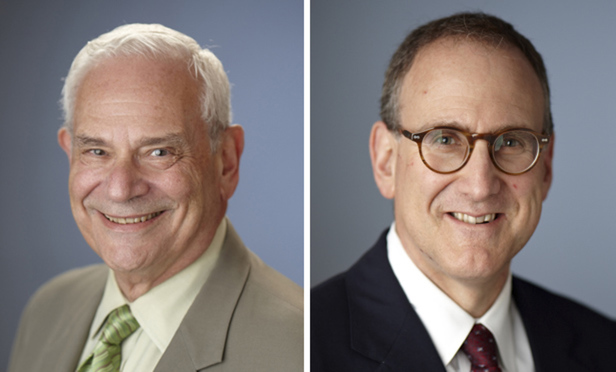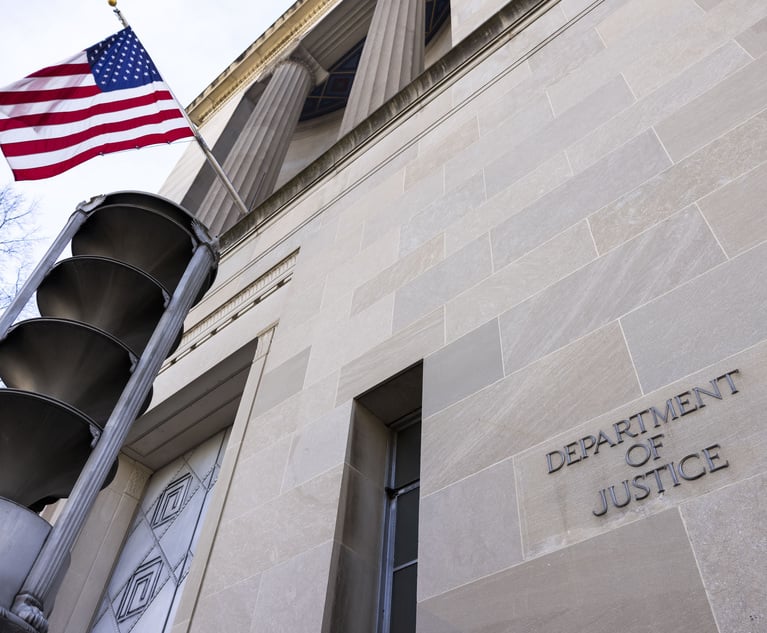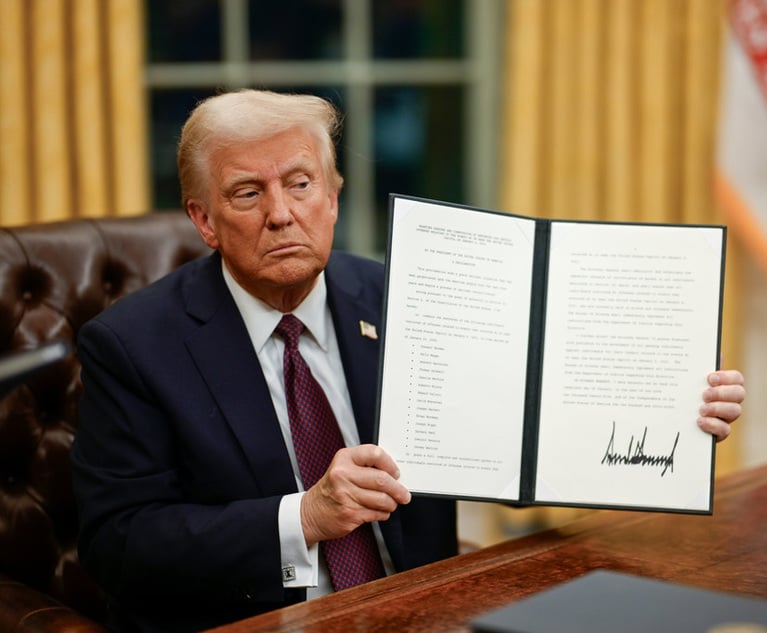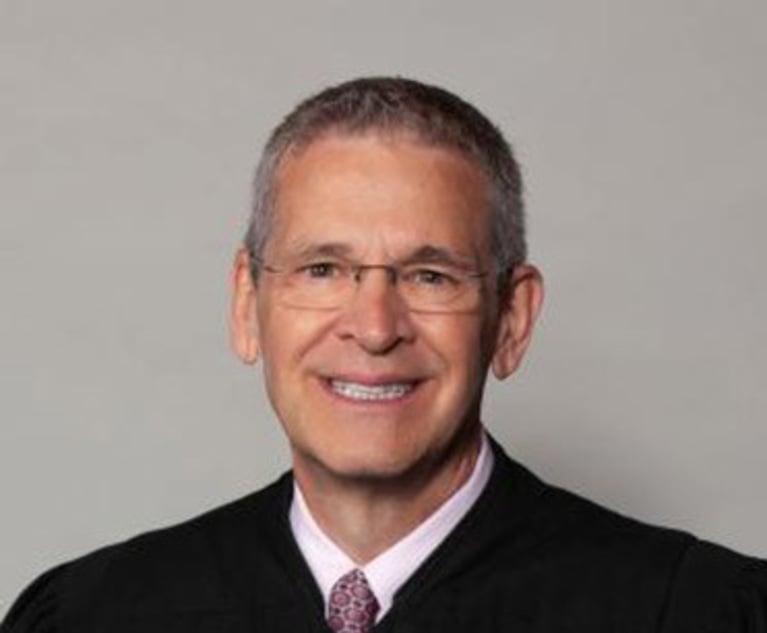Government Misconduct in a Grand Jury Investigation: Is There a Remedy?
White-Collar Crime columnists Elkan Abramowitz and Jonathan S. Sack provide a brief examination of the heavy burden on defendants who claim misconduct in grand jury proceedings. They then discuss a recent Second Circuit decision, which illustrates the reluctance of federal courts to dismiss charges and overturn jury verdicts based on prosecutorial misconduct, even when the government concedes that serious misconduct occurred.
January 07, 2019 at 02:45 PM
11 minute read
 Elkan Abramowitz and Jonathan Sack
Elkan Abramowitz and Jonathan Sack
As defense counsel we sometimes encounter inappropriate conduct by the government. Misconduct can occur in different phases of a case—during an investigation, in post-indictment discovery (including Brady material disclosure), and at trial. The remedy for perceived misconduct is usually narrow in scope, such as adjournment to allow more time to review late discovery, or, in more serious instances, preclusion of evidence. After a conviction, a defendant can sometimes secure a new trial. Federal law strongly disfavors the most severe remedy—dismissal of charges—on the premise that in all but the most exceptional cases defendants should not benefit from the misbehavior of prosecutors and law enforcement agencies.
But what should the remedy be when government officials engage in misconduct in the grand jury and potentially cause charges to be filed that might not otherwise have been brought? This issue was recently explored in depth in the prosecution for insider trading of well-known sports gambler, Billy Walters. Walters argued that improper leaks of information to the press led to his indictment and warranted dismissal of criminal charges notwithstanding his later conviction at trial. After condemning the misconduct, the Second Circuit rejected dismissal as the appropriate remedy and affirmed the conviction. United States v. Walters, 910 F.3d 11 (2d Cir. 2018).
In this article, we begin with a brief examination of the heavy burden on defendants who claim misconduct in grand jury proceedings. We then discuss the Second Circuit's decision in Walters, which illustrates the reluctance of federal courts to dismiss charges and overturn jury verdicts based on prosecutorial misconduct, even when the government concedes that serious misconduct occurred.
The High Bar to Dismissal
Once an indictment is handed up, grand jury proceedings have a “presumption of regularity.” See Hamling v. United States, 418 U.S. 87, 139 n.23 (1974). This means that, absent a “strong showing to the contrary,” courts will presume that any irregularities occurring during the grand jury process are harmless. United States v. R. Enters., 498 U.S. 292, 300-01 (1991). The Supreme Court has thus held that courts should not look behind the facial validity of an indictment, for example, by considering the nature and admissibility of evidence presented in the grand jury. See United States v. Costello, 350 U.S. 359, 408-09 (1956) (affirming district's denial of motion to dismiss on the ground that only hearsay was presented in the grand jury); United States v. Williams, 504 U.S. 36, 54-55 (1992) (reversing district court's dismissal of an indictment on the ground that prosecutors had failed to present exculpatory evidence to the grand jury).
Consistent with this presumption of regularity, the Supreme Court has constructed a high bar for motions to dismiss indictments based on government misconduct in grand jury proceedings. In Bank of Nova Scotia v. United States, 487 U.S. 250 (1988), the court established a presumption of harmless error, which defendants may overcome only by showing that they suffered prejudice or, in the absence of prejudice, that the government engaged in behavior that “shocked the conscience” and compromised the fundamental fairness of the proceedings. 487 U.S. at 255-57. Dismissal is particularly difficult to secure following a conviction at trial. In United States v. Mechanik, the Supreme Court held that a guilty verdict “render[s] harmless any conceivable error in the charging decision that might have flowed from the violation.” 475 U.S. 66, 73 (1986). As the Court explained, “the societal costs of retrial after a jury verdict of guilty are far too substantial to justify setting aside the verdict simply because of an error in the earlier grand jury proceedings.” Id.
The Supreme Court has established two exceptions to the harmless-error rule. First, courts may exercise their supervisory power to dismiss an indictment when a defendant establishes prejudice—i.e., that the government's misconduct “substantially influenced the grand jury's decision to indict,” or created “grave doubt that the decision to indict was free from the substantial influence of such” misconduct. Bank of Nova Scotia, 487 U.S. at 256. Second, courts may dismiss an indictment without a separate inquiry into prejudice when prosecutorial misconduct is so severe that it may be deemed a fundamental violation of due process—i.e., when “the structural protections of the grand jury have been so compromised as to render the proceedings fundamentally unfair, allowing the presumption of prejudice.” Id. at 257. The Supreme Court has described such cases as “isolated exceptions to the harmless-error rule,” id. at 256, and has found such fundamental misconduct only in the context of racial and gender-based discrimination in the selection of grand jurors. See Vasquez v. Hillery, 474 U.S. 254 (1986); Ballard v. United States, 329 U.S. 187 (1946).
The Second Circuit has closely adhered to the Supreme Court's harmless-error standard. See, e.g., United States v. Morrison, 153 F.3d 34, 55 (2d Cir. 1998) (holding that jury's guilty verdict “rendered harmless any error resulting from” presentation of allegedly perjured testimony and altered tape recordings to grand jury); United States v. Ruggiero, 934 F.2d 440, 447-48 (2d Cir. 1991) (declining to dismiss indictment based on alleged exaggeration by prosecutor regarding content of tapes presented to grand jury, since “any possibility of prejudice was eliminated by the petit jury's conviction … after hearing the tapes in their entirety”).
'United States v. Walters'
The Second Circuit's recent decision in Walters illustrates just how high the bar is for dismissal of an indictment based on government misconduct. In May 2016, the government charged Walters with insider trading and related offenses. After a three-week trial in March 2017, Walters was convicted and sentenced to five years' imprisonment and ordered to pay fines, forfeiture, and restitution totaling more than $44 million.
In pre-trial motion practice, Walters moved for an evidentiary hearing on the ground that the government had leaked confidential grand jury information to the press in violation of Federal Rule of Criminal Procedure 6(e). The government initially opposed the motion, arguing that Walters could not show that the source of any leaks was a government agent. Subsequently, the government submitted a letter to the court which acknowledged, based on the U.S. Attorney's Office's own inquiry, that FBI Supervisory Special Agent David Chaves had leaked information relating to the grand jury investigation to reporters for The Wall Street Journal and The New York Times.
The government's letter described its investigative steps, including interviews of 14 employees of the U.S. Attorney's Office and the FBI, as well as a review of thousands of emails, text messages, and phone records. According to the government, from April 2013 to June 2014 Special Agent Chaves leaked confidential grand jury information to reporters on multiple occasions, and, as a result of these leaks, several articles appeared in the Journal and the Times in May and June 2014. The articles, which attributed the leaked information to “people briefed on the matter,” disclosed the existence of grand jury subpoenas and revealed information regarding targets of the investigation (including Walters), specific trades being investigated, evidence being examined, and theories of liability the government was exploring. The government represented that Special Agent Chaves had been referred to the FBI's Office of Professional Responsibility and the DOJ's Office of the Inspector General to consider appropriate sanctions. In light of the government's letter, the district court presumed that a Rule 6(e) violation had occurred and decided that a previously scheduled evidentiary hearing was not necessary.
After the government's submission, Walters moved to dismiss the indictment, arguing that the leaks prejudiced him by reviving a dormant investigation and encouraging a co-defendant to cooperate against him, thereby increasing the likelihood that the grand jury would return an indictment. Walters further argued that, even absent a showing of prejudice, the indictment should be dismissed because the government misconduct at issue was “systematic and pervasive,” and so “outrageous” that it violated his right to due process. Walters pointed to five examples of white-collar criminal investigations involving Special Agent Chaves in which defendants had alleged improper leaks to the press. Walters maintained that “there is no indication that anything was ever done to investigate, much less stop, this clear pattern of illegal leaks” prior to the “belated investigation” in the Walters case. United States v. Walters, No. 16-cr-338 (PKC), ECF No. 68 at 36-42, 54-55 (S.D.N.Y. Jan. 13, 2017).
The district court denied Walters' motion to dismiss, finding that it was “sheer speculation” to link the FBI leaks and resulting newspaper articles to Walters' eventual indictment. The court concluded that the “proper remedy” was to “investigate and, if appropriate, prosecute the offender, rather than dismiss the indictment.” The court also held that an evidentiary hearing was unnecessary because Special Agent Chaves had indicated that he would invoke his Fifth Amendment rights and refuse to answer any questions and, in any event, the court had “been provided sufficient evidence … to make a ruling.” 910 F.3d at 20-21.
The Second Circuit Decision
On appeal, Walters argued that government misconduct during the grand jury investigation called for dismissal of the indictment. The Second Circuit rejected the argument and affirmed the conviction.
After the court made clear that it regarded the leaks as “highly improper” and “likely criminal,” the Second Circuit nevertheless concluded that dismissal was not justified because Walters had not shown that he was prejudiced by the leaks—i.e., that the leaks had “substantially influenced the grand jury's decision to indict.” Id. at 23. The court rejected Walters' argument that Special Agent Chaves' leaks revived a dormant investigation, concluding that “the investigation was in fact alive and ongoing when he leaked the information.” Id. at 24. The court also rejected the claim that leaks and newspaper articles had influenced a co-defendant's decision to cooperate. The court observed that the co-defendant's decision to cooperate came six months after publication of the articles and pointed to the co-defendant's testimony at trial that his decision stemmed from his counsel's advice that he was likely to be indicted. Id. Finding that “Walters received a full and fair trial in which there was overwhelming evidence to support his conviction,” the court concluded that dismissal of Walters' indictment would improperly punish society for the misdeeds of one errant FBI agent. Id.
The court similarly rejected Walters' argument that dismissal was warranted absent a separate showing of prejudice because the government's misconduct was “systematic and pervasive.” The court relied on the holding in Bank of Nova Scotia, in which the Supreme Court offered only two examples of government misconduct during the grand jury process sufficient to presume prejudice: “[1] racial discrimination in the selection of grand jurors and [2] the exclusion of women from the grand jury.” Id. at 25. Although the court described the leaks to the media as “deeply troubling,” the court concluded that they were not sufficient to warrant the “drastic remedy” of dismissal. Id. at 26. Disciplinary proceedings and criminal investigation were sufficient remedies to address the misconduct. Id. at 27.
Finally, the court held that Walters had not met the “very heavy” burden of showing that Special Agent Chaves' conduct was so “outrageous” as to constitute a due process violation. To obtain dismissal of an indictment on this ground, the misconduct at issue must be “so offensive that it shocks the conscience,” such as when the government obtains convictions as a result of coercion or violation of a defendant's bodily integrity. Id. The court held that the “deeply disturbing and perhaps even criminal” misconduct at issue was “not commensurate with the conduct in those cases where indictments were dismissed for coercion or violations of bodily integrity.” Id. at 28.
Conclusion
Under federal law, the remedy for government misconduct in a criminal case will ordinarily be narrowly tailored to the misconduct in question; only in rare cases will the proper remedy be dismissal of an indictment. That is the reality illustrated in Walters in the context of grand jury proceedings—and suggested by the late Justice Thurgood Marshall who, in dissent in Bank of Nova Scotia, observed that the majority's harmless-error standard of review “reduces Rule 6 to little more than a code of honor that prosecutors can violate with virtual impunity.” 487 U.S. at 265 (Marshall, J., dissenting). Defense counsel must establish that a particular instance of government misconduct is so severe that it casts doubt on the fundamental fairness of the proceedings. Given the difficulty of making that showing, particularly after a conviction at trial, dismissal of charges will be available to defendants only in the most unusual and extreme cases of government misconduct.
Elkan Abramowitz and Jonathan Sack are members of Morvillo Abramowitz Grand Iason & Anello P.C. Mr. Abramowitz is a former chief of the criminal division in the U.S. Attorney's Office for the Southern District of New York. Mr. Sack is a former chief of the criminal division in the U.S. Attorney's Office for the Eastern District of New York. Justin Roller, an associate of the firm, contributed to this article.
This content has been archived. It is available through our partners, LexisNexis® and Bloomberg Law.
To view this content, please continue to their sites.
Not a Lexis Subscriber?
Subscribe Now
Not a Bloomberg Law Subscriber?
Subscribe Now
NOT FOR REPRINT
© 2025 ALM Global, LLC, All Rights Reserved. Request academic re-use from www.copyright.com. All other uses, submit a request to [email protected]. For more information visit Asset & Logo Licensing.
You Might Like
View All
Justice 'Weaponization Working Group' Will Examine Officials Who Investigated Trump, US AG Bondi Says

'A Shock to the System’: Some Government Attorneys Are Forced Out, While Others Weigh Job Options
7 minute read
Trending Stories
- 1States Accuse Trump of Thwarting Court's Funding Restoration Order
- 2Microsoft Becomes Latest Tech Company to Face Claims of Stealing Marketing Commissions From Influencers
- 3Coral Gables Attorney Busted for Stalking Lawyer
- 4Trump's DOJ Delays Releasing Jan. 6 FBI Agents List Under Consent Order
- 5Securities Report Says That 2024 Settlements Passed a Total of $5.2B
Who Got The Work
J. Brugh Lower of Gibbons has entered an appearance for industrial equipment supplier Devco Corporation in a pending trademark infringement lawsuit. The suit, accusing the defendant of selling knock-off Graco products, was filed Dec. 18 in New Jersey District Court by Rivkin Radler on behalf of Graco Inc. and Graco Minnesota. The case, assigned to U.S. District Judge Zahid N. Quraishi, is 3:24-cv-11294, Graco Inc. et al v. Devco Corporation.
Who Got The Work
Rebecca Maller-Stein and Kent A. Yalowitz of Arnold & Porter Kaye Scholer have entered their appearances for Hanaco Venture Capital and its executives, Lior Prosor and David Frankel, in a pending securities lawsuit. The action, filed on Dec. 24 in New York Southern District Court by Zell, Aron & Co. on behalf of Goldeneye Advisors, accuses the defendants of negligently and fraudulently managing the plaintiff's $1 million investment. The case, assigned to U.S. District Judge Vernon S. Broderick, is 1:24-cv-09918, Goldeneye Advisors, LLC v. Hanaco Venture Capital, Ltd. et al.
Who Got The Work
Attorneys from A&O Shearman has stepped in as defense counsel for Toronto-Dominion Bank and other defendants in a pending securities class action. The suit, filed Dec. 11 in New York Southern District Court by Bleichmar Fonti & Auld, accuses the defendants of concealing the bank's 'pervasive' deficiencies in regards to its compliance with the Bank Secrecy Act and the quality of its anti-money laundering controls. The case, assigned to U.S. District Judge Arun Subramanian, is 1:24-cv-09445, Gonzalez v. The Toronto-Dominion Bank et al.
Who Got The Work
Crown Castle International, a Pennsylvania company providing shared communications infrastructure, has turned to Luke D. Wolf of Gordon Rees Scully Mansukhani to fend off a pending breach-of-contract lawsuit. The court action, filed Nov. 25 in Michigan Eastern District Court by Hooper Hathaway PC on behalf of The Town Residences LLC, accuses Crown Castle of failing to transfer approximately $30,000 in utility payments from T-Mobile in breach of a roof-top lease and assignment agreement. The case, assigned to U.S. District Judge Susan K. Declercq, is 2:24-cv-13131, The Town Residences LLC v. T-Mobile US, Inc. et al.
Who Got The Work
Wilfred P. Coronato and Daniel M. Schwartz of McCarter & English have stepped in as defense counsel to Electrolux Home Products Inc. in a pending product liability lawsuit. The court action, filed Nov. 26 in New York Eastern District Court by Poulos Lopiccolo PC and Nagel Rice LLP on behalf of David Stern, alleges that the defendant's refrigerators’ drawers and shelving repeatedly break and fall apart within months after purchase. The case, assigned to U.S. District Judge Joan M. Azrack, is 2:24-cv-08204, Stern v. Electrolux Home Products, Inc.
Featured Firms
Law Offices of Gary Martin Hays & Associates, P.C.
(470) 294-1674
Law Offices of Mark E. Salomone
(857) 444-6468
Smith & Hassler
(713) 739-1250







